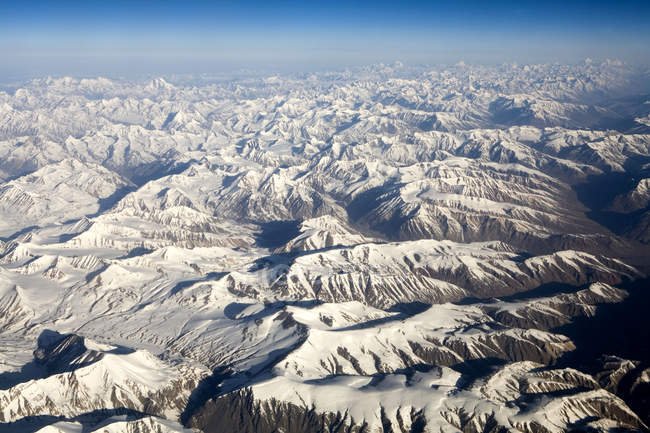By Maj Gen Dhruv C Katoch

China’s expansionist plans for the Himalayan region pose long term threat to peace and stability in South Asia.
Keywords: Ladakh | Aksai Chin | Tibet | Himalayas | Eastern Front | Brahmaputra river | South Asia
Soon after the Chinese Communist Party (CCP) assumed power in China, its Chairman, Mao Zedong, described Tibet as China’s right palm and Ladakh, Nepal, Sikkim, Bhutan, and Arunachal Pradesh as its five fingers. Mao’s expansionist policies became evident when he annexed Tibet in 1950 and then devoted his attention to dominating, if not taking over the entire Himalayan range. Because the world was silent when China occupied Tibet, the CCP was emboldened to move towards the five fingers.
China made its first move towards Ladakh when it started construction of a 1200 km long road connecting East Turkestan (Xinjiang) with Western Tibet, of which 179 km of the road passed through the Aksai Chin, which was part of Ladakh. China began construction of this road in 1951 and completed the same in 1957. Surprisingly, India’s political establishment, as well as its intelligence agencies, remained blissfully unaware of Chinese incursions into the Aksai Chin till the Chinese themselves publicly inaugurated this road and marked it on their maps. India found that it could do little to change the status quo, other than making feeble protests.
India’s post-independence political leadership was, for some unfathomable reasons, enamoured with the Chinese ruling establishment and never for a moment thought that they had a potential enemy at their doorsteps. This lack of strategic comprehension of what national security demanded was in ample display in an incident which occurred shortly after India achieved independence on 15 August 1947. As per certain biographical records, General Sir Rob Lockhart, a British officer who was appointed as the Commander in Chief of the Indian Army, took a strategic plan to the prime minister, asking for a government directive on the defence policy. Mr Nehru blew his top. “Rubbish,” he shouted, “total rubbish! We don’t need a defence plan. Our policy is ahimsa (non-violence). We foresee no military threats. Scrap the army! The police are good enough to meet our security needs”.
This lack of strategic thought was to cost India dearly. In 1950, China annexed the palm which Mao had spoken off, and within a few years thereafter, they had sliced off a portion of the Ladakh finger—the Aksai Chin. As the world quietly acquiesced to an expansionist China, it continued with its plans to control the fingers. Thus was born the Chinese rationale of staking claims over the Indian state of Arunachal Pradesh, all the while keeping a surreptitious glance at the rest of Ladakh, where their focus was on Gilgit-Baltistan. This region was part of the Ladakh Wazarat during the Dogra rule but was illegally occupied by Pakistan post-independence. In an agreement signed between Pakistan and China on 2 March 1963, Pakistan ceded the Shaksgam Valley—an area of approximately 7000 square kilometres bounded by the Kun Lun Mountains in the north and the Karakoram peaks to the south, to China. Today, Chinese forays into Gilgit Baltistan, through the China-Pakistan Economic Corridor (CPEC), has given China virtual control over this region.
Chinese actions in Eastern Ladakh and Sikkim in May-June 2020, their claims over Arunachal Pradesh, their recent forays in Nepal and their constant needling of Bhutan must be seen in the light of their long term aim to gain control over the entire Himalayan range. This gives China direct access to the waters which flow into the downstream countries, which in turn gives Beijing leverage over South Asia. At present, in the Eastern Himalayas, the Chinese control little water except for the Yarlung Tsangpo (the name of the Brahmaputra River as it flows in Tibet). The river takes a U-turn at its Eastern extremity as it circumvents the Namcha Barwa massif and enters Arunachal Pradesh as the Siang River. But the waters of the Tsangpo are just a small part of the total waters of the Brahmaputra River which eventually drain into the Bay of Bengal. Even if China were somehow to develop the technology to transfer the Tsangpo waters in a cost-effective manner to its own parched lands, the impact on the downstream countries would not be significant as the catchment areas of the Brahmaputra River are the Southern slopes of the Eastern Himalayas. This explains Beijing’s motive for claiming Arunachal Pradesh.
Likewise, China is angling for influence and domination in Nepal and Bhutan and is seeking to exert pressure on India in Sikkim and Eastern Ladakh. Should China get control, it would facilitate dam construction and enable the regulation and flow of water to the downstream countries, forcing them to remain in China’s servitude. That appears to be China’s larger game plan for gaining control over the five fingers. In addition, the glacial waters which China hopes to get through this land grab would service its massive semi-conductor industries. A typical semiconductor manufacturing facility uses 2-4 million gallons of ultra-pure water per day. Eastern Ladakh, in addition, also provides China with an opportunity to shorten the loop of the BRI-CPEC sustaining Western Karakoram Highway via Kashgar and to connect a fresh alignment through the Karakoram Pass, shortening the present highway passing through East Turkestan by 1800 km.
China aims to be the sole power in Asia and the alternate pole to the US in the world. Towards this end, it seeks Indian Territory in the Himalayan Range, which will provide it great strategic advantage through control of water and shortening communication links. It is an expansionistic plan which must be nipped in the bud. The surest way for India to protect its territorial integrity is to eliminate the threats to the five fingers which emanate from Tibet. If this is effectively calibrated, the Himalayas will once again be the traditional abode of peace, ushering in prospects for progress and stability in South Asia.
Views expressed are personal and do not necessarily reflect the views of India Foundation.






Pt Nehru never came to know that a road was being built in Ladakh
Nehru was in his own world
he never foresaw military threats
Of what use was his learning if he had to take a religious stand like Dalai or Shankaracharya?
It was TOTAL LACK OF VISION on part of Nehru
he got what he wanted that is prime minister-ship
He never took advise of Sardar either
Successive govts did not do much
Nehru policies continued till now
China wants to control water flow that gives Beijing leverage over South Asia
It needs large quantity of water for semiconductor manufacturing facility
INDIA NEEDS TO TAKE CHARGE OF NEPAL
China is on a land grab mission
What is India’s plan on POK Gilgit Balistan?
how to deal with Pakistan’s illegal lease to China of Indian land?
US has woken up after COVID crisis
US has made China
USA overlooked human rights in China
still allows trade to continue
Look how the Uighurs are massacres
China’s atrocities are still hidden
why is China still in UNHRC?
now same money is used against USA
COVID has TRULY woken up India too
INDIA should never make another mistake
Show China its place
INDIA MUST INK A PACT WITH USA at the EARLIEST
Sir, Very well explained. The issue right now is how to correct the historical mistakes committed by us. The world had changed, and a permanent solution I only see if Tibet is an independent nation and acts as a buffer state between India and China. We have a lot at stake, and a solution no matter how expensive it is has to be thought of. We can brain storm on this.
[…] consideration of Ladakh, Nepal, Bhutan, Sikkim and Arunachal Pradesh as the five fingers of China’s right palm Tibet, reflects the colonising psyche. In the post-Mao era, the Communist Party shifted […]